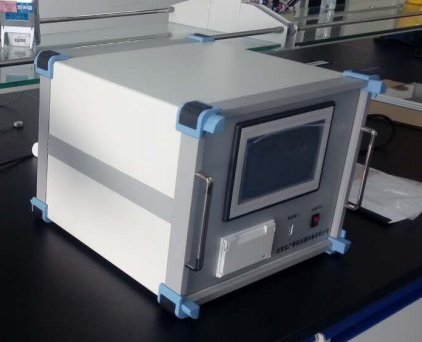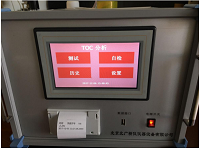河北纯化水总有机碳分析仪 更换蠕动泵管
蠕动泵管在长期运行后会有磨损和老化现象,所以必须定期更换。
河北纯化水总有机碳分析仪 更换泵管的操作步骤如下:
○1 关闭主电源开关,拔去电源线。
○2 按下泵头下部的金属弹片,弹出两个塑料卡片。
○3 从甭管的接头处拆下旧的蠕动甭管,取下套在甭管上的抱箍,将抱箍套在新
的蠕动泵管上,然后将新的甭管装入仪器的接头上,要注意抱箍的位置及方向。
○4 将甭管嵌入两个塑料卡片,然后向下压入卡位。按下时一定要注意甭管是否
入槽。
○5 调整卡片上的流速调节键,要注意调整的原则是:管路出液口的液体顺畅自
然,无回流。条件允许的话,请使用高精度的量筒对出液速度进行测量,使液体的流
速与仪器的流速设置值相对应。
更换以上部件时存在问题可联系仪器厂家解决。
UV 灯和蠕动泵管可以从本公司购买。 UV 灯为 185nm、254nm 双波长紫外
灯,蠕动泵管为原装进口泵管,具有很高可靠性和良好的稳定性。
UV 灯的使用周期为 6 个月 ;蠕动泵管的使用周期为 12 个月。
以上时间为系统连续在线运行时间,当用采用间断或离线运行时,更换周期将会更长,仪器会自动完成计数并决定何时告警。
主要配置
主机 一台
触摸屏 (镶嵌到仪器中)
微型打印机 一台
进样管 一条
电源线 一套
产品说明书 一份
产品合格证 一份
产品装箱单 一份
应用领域:
制药用水(纯化水、注射用水)的在线监测和实验室测试,以及清洁验证;环保测试、电子行业、食品行业等。
燃烧氧化法
其中燃烧氧化—非分散红外吸收法优势是只需一次性转化,流程简单、重现性好、灵敏度高,缺点是探测器需频繁校准,体积大及预热时间长,必须使用酸、催化剂和载气。
TOC分析仪主要由以下几个部分构成:进样口、无机碳反应器、有机碳氧化反应(或是总碳氧化反应器)、气液分离器、非分光红外CO2分析器、数据处理部分。
燃烧氧化—非分散红外吸收法,按测定TOC值的不同原理又可分为差减法和直接法两种。
⒈差减法测定TOC值的方法原理
水样分别被注入高温燃烧管(900℃)和低温反应管(150℃)中。经高温燃烧管的水样受高温催化氧化,使有机化合物和无机碳酸盐均转化成为二氧化碳。经反应管的水样受酸化而使无机碳酸盐分解成为二氧化碳,其所生成的二氧化碳依次导入非分散红外检测器,从而分别测得水中的总碳(TC)和无机碳(IC)。总碳与无机碳之差值,即为总有机碳(TOC)。
⒉直接法测定TOC值的方法原理
将水样酸化后曝气,使各种碳酸盐分解生成二氧化碳而驱除后,再注入高温燃烧管中,可直接测定总有机碳。但由于在曝气过程中会造成水样中挥发性有机物的损失而产生测定误差,因此其测定结果只是不可吹出的有机碳值。
超临界水氧化法
超零界水氧化(Supercritical Water Oxidation—SCWO)技术原先被用于处理大体积废水、污泥和被污染
性能规格:
测量范围:0.001mg/L~1.0mg/L(传感器可定制,浓度可调节最达到1000mg/L,根据式样要求传感器定制调节到某一段浓度范围)
精度:?4%测试范围
分辨率:0.001mg /L
分析时间:连续分析
响应时间:4分钟之内
检测极限:0.001mg /L
样品温度:1- 95℃
重复性误差:≤3%
电源要求/功能:220V
显示屏:彩色触摸屏
离线检测
离线检测时,仪器可从样品瓶或其它没有压力的容器直接取样。仪器管路冲洗和仪器校准应在离线状态操作。若样品中有不可溶性微粒,应经过滤膜(孔径60μm或更小)过滤后进入仪器,以防止样品中的微粒阻塞仪器。仪器的进样管为1/16英寸的Teflon管,经蠕动泵抽进管路中的水样流速约为0.5 ml/min。
系统组成
TOC分析仪的组成包括以下7个主要部分:
① 在线检测装置(在线型仪器配备)
② 样品蠕动泵
③ 分流器
④ 氧化反应器
⑤ 二氧化碳传感器
⑥ 微处理控制器和电子线路板
⑦ 输出接口
氧化反应器
仪器利用UV射线在二氧化钛光催化剂的作用下将有机化合物氧化成二氧化碳,氧化反应器是一个UV灯外包螺旋形的石英管。UV灯发出185nm和254nm的光线,使水产生光分解。
H2O hν(185nm)(TiO2)? OH? H?
羟基自由基(OH?)能完全把有机化合物氧化为二氧化碳。
有机物 OH?? CO2 H2O
UV灯的使用寿命为6个月,当更换时间到期时仪器将出现警告信息,提醒用户更换UV灯。
Replace the peristaltic pump tube
The peristaltic pump tube will experience wear and aging after long-term operation, so it must be replaced regularly.
The steps for replacing the pump tube are as follows:
Turn off the main power switch and unplug the power cord.
Press the metal spring at the bottom of the pump head to pop out two plastic cards.
○3 Remove the old peristaltic pipe from the joint of the pipe, take off the clamp on the pipe, and put the clamp on the new one
Connect the peristaltic pump tube and then insert the new tube into the connector of the instrument, paying attention to the position and direction of the clamp.
Insert two plastic cards and press them down into the slot. Be sure to pay attention when pressing, regardless of whether it is pressed or not
Enter the slot.
Adjust the flow rate adjustment button on the card, and pay attention to the principle that the liquid at the outlet of the pipeline should flow smoothly
However, there is no backflow. If conditions permit, please use a high-precision measuring cylinder to measure the liquid outlet velocity and ensure the flow of the liquid
The speed corresponds to the flow rate setting value of the instrument.
If there are any problems when replacing the above components, please contact the instrument manufacturer for resolution.
UV lamps and peristaltic pump tubes can be purchased from our company. The UV lamp has dual wavelength ultraviolet of 185nm and 254nm
The lamp and peristaltic pump tube are original imported pump tubes with high reliability and good stability.
The usage cycle of UV lamps is 6 months; The service life of peristaltic pump tubing is 12 months.
The above time is the continuous online operation time of the system. When using intermittent or offline operation, the replacement cycle will be longer, and the instrument will automatically complete the counting and determine when to alarm.
Main configuration
One host
Touch screen (embedded in the instrument)
One micro printer
One injection tube
A set of power cords
One copy of product manual
One copy of product qualification certificate
Product packing list copy
Application areas:
Online monitoring and laboratory testing of pharmaceutical water (purified water, injection water), as well as cleaning validation; Environmental testing, electronics industry, food industry, etc.
Combustion oxidation method
The advantage of combustion oxidation non dispersive infrared absorption method is that it only requires one-time conversion, has a simple process, good reproducibility, and high sensitivity. The disadvantage is that the detector needs to be calibrated frequently, has a large volume and long preheating time, and must use acid, catalyst, and carrier gas.
The TOC analyzer mainly consists of the following parts: injection port, inorganic carbon reactor, organic carbon oxidation reaction (or total carbon oxidation reactor), gas-liquid separator, non dispersive infrared CO2 analyzer, and data processing part.
The combustion oxidation non dispersive infrared absorption method can be divided into two types based on different principles for determining TOC values: differential method and direct method.
Principle of the method for determining TOC value by subtraction method
The water samples were injected into high-temperature combustion tubes (900℃) and low-temperature reaction tubes (150℃) respectively. The water sample passing through the high-temperature combustion tube is subjected to high-temperature catalytic oxidation, converting both organic compounds and inorganic carbonates into carbon dioxide. The water sample passing through the reaction tube is acidified, causing inorganic carbonates to decompose into carbon dioxide. The generated carbon dioxide is then sequentially introduced into a non dispersive infrared detector to measure the total carbon (TC) and inorganic carbon (IC) in the water. The difference between total carbon and inorganic carbon is called total organic carbon (TOC).
2. Principle of direct method for determining TOC value
After acidifying the water sample and aerating it, various carbonates are decomposed to produce carbon dioxide, which is then removed and injected into a high-temperature combustion tube for direct measurement of total organic carbon. However, due to the loss of volatile organic compounds in the water sample during the aeration process, measurement errors may occur, so the measurement result is only the organic carbon value that cannot be blown out.
Supercritical water oxidation method
The Supercritical Water Oxidation (SCWO) technology was originally used to treat large volumes of wastewater, sludge, and pollution
Performance specifications:
Measurement range: 0.001mg/L~1.0mg/L (The sensor can be customized, and the concentration can be adjusted up to 1000mg/L. The sensor can be customized and adjusted to a certain concentration range according to the style requirements)
Accuracy:?4% Test range
Resolution: 0.001mg/L
Analysis time: continuous analysis
Response time: within 4 minutes
Detection limit: 0.001mg/L
Sample temperature: 1-95℃
Repetitive error:≤3%
Power requirement/function: 220V
Display screen: Color touch screen
Offline detection
When conducting offline testing, the instrument can directly sample from sample bottles or other containers without pressure. Instrument pipeline flushing and instrument calibration should be operated offline. If there are insoluble particles in the sample, they should be filtered through a filter membrane (with a pore size of 60μm or smaller) before entering the instrument to prevent particles from blocking the instrument. The injection tube of the instrument is a 1/16 inch Teflon tube, and the flow rate of the water sample drawn into the pipeline by a peristaltic pump is about 0.5 ml/min.
system composition
The composition of TOC analyzer includes the following 7 main parts:
①Online detection device (equipped with online instruments)
②Sample peristaltic pump
③Diverter
④Oxidation reactor
⑤Carbon dioxide sensor
⑥Microprocessor controllers and electronic circuit boards
⑦Output interface
Oxidation reactor
The instrument uses UV rays to oxidize organic compounds into carbon dioxide under the action of titanium dioxide photocatalyst. The oxidation reactor is a spiral quartz tube wrapped around a UV lamp. The UV lamp emits light at 185nm and 254nm to decompose aquatic products.
H2O hν(185nm)(TiO2)OH? H?
Hydroxyl radicals (OH?) can completely oxidize organic compounds to carbon dioxide.
Organic compounds OH?CO2 H2O
The service life of UV lamps is 6 months. When the replacement time expires, the instrument will display a warning message to remind the user to replace the UV lamp.